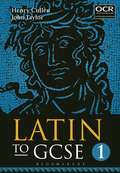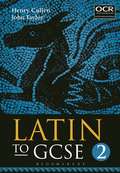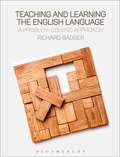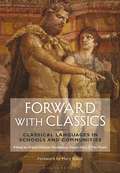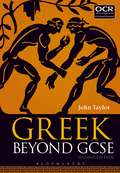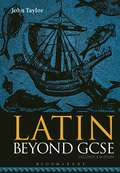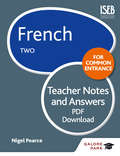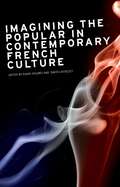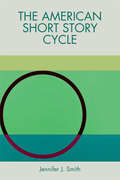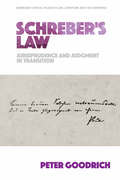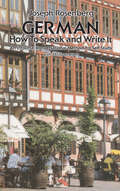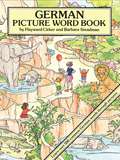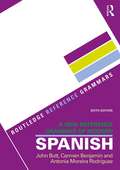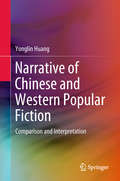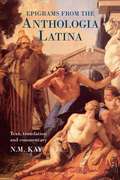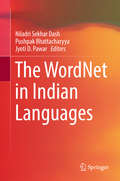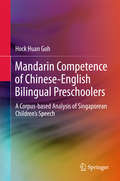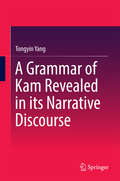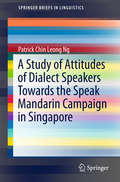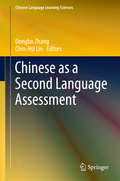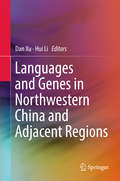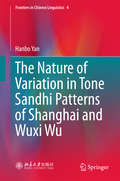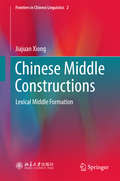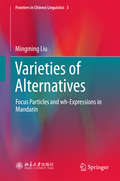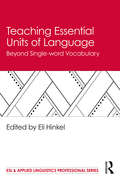- Table View
- List View
Latin to GCSE Part 1
by Henry Cullen John TaylorA companion to Bloomsbury's popular two-volume Greek to GCSE, this is the first course for Latin students that directly reflects the curriculum in a clear, concise and accessible way. Enhanced by colour artwork and text features, the books support the new OCR specification for Latin (first teaching 2016) as well as meeting the needs of later students, both at university and beyond.Written by two experienced school teachers, one also an examiner, the course is based on a keen understanding of what pupils find difficult, concentrating on the essentials and on the explanation of principles in both accidence and syntax: minor irregularities are postponed and subordinated so that the need for rote learning is reduced. User-friendly, it also gives pupils a firm foundation for further study. Part 1 covers the basics and is self-contained, with its own reference section. It outlines the main declensions, a range of active tenses and a vocabulary of 275 Latin words to be learned. Pupil confidence is built up by constant consolidation of the material covered. After the preliminaries, each chapter concentrates on stories with one source or subject: the Fall of Troy, the journeys of Aeneas, the founding of Rome and the early kings, providing an excellent introduction to Roman culture alongside the language study.
Latin to GCSE Part 2
by Henry Cullen John TaylorA companion to Bloomsbury's popular two-volume Greek to GCSE, this is the first course for Latin students that directly reflects the curriculum in a clear, concise and accessible way. Enhanced by colour artwork and text features, the books support the new OCR specification for Latin (first teaching 2016) as well as meeting the needs of later students, both at university and beyond.Written by two experienced school teachers, one also an examiner, the course is based on a keen understanding of what pupils find difficult, concentrating on the essentials and on the explanation of principles in both accidence and syntax: minor irregularities are postponed and subordinated so that the need for rote learning is reduced. User-friendly, it also gives pupils a firm foundation for further study. Part 1 covers the basics, whilst Part 2 introduces a wider range of grammatical forms and constructions, with a vocabulary of 450 words and reading material about the developing Republic, the war with Hannibal, the rise of Julius Caesar, and Augustus and the early emperors. Practice passages and revision sentences for GCSE complete Part 2, which has a reference section covering the whole course.
Teaching and Learning the English Language: A Problem-Solving Approach
by Richard BadgerTeaching and Learning the English Language is a practical guide for anyone seeking to improve their teaching, whether through formal study or on their own. Richard Badger explores teaching English as a problem-solving activity in which teachers must address three fundamental questions: · what aspect of language do students need to learn;· how might they learn this particular aspect of language;· and how can teachers support their learning. Offering a solid, research-based approach along with sound practical advice, this book equips teachers with skills needed to analyse their own contexts and develop their practice. It covers:· Fundamentals of English language · Psychological and social learning processes · TESOL teaching methods and approaches· Lesson planning and classroom management· Language evaluation and assessment· Teaching pronunciation, spelling, grammar, vocabulary and discourse· Teaching listening, reading, writing and speaking· English teacher professional developmentPedagogical features include chapter summaries, activities for students and key readings recommendations, and the book is also supported by online resources: video case studies, additional exercises and multiple choice quizzes. Including numerous international lesson examples and case studies, Teaching and Learning English Language is suitable for both trainee and practising teachers who speak English as a first, second or foreign language.
Forward with Classics: Classical Languages in Schools and Communities
by Arlene Holmes-Henderson Steven Hunt Mai MusiéDespite their removal from England's National Curriculum in 1988, and claims of elitism, Latin and Greek are increasingly re-entering the 'mainstream' educational arena. Since 2012, there have been more students in state-maintained schools in England studying classical subjects than in independent schools, and the number of schools offering Classics continues to rise in the state-maintained sector. The teaching and learning of Latin and Greek is not, however, confined to the classroom: community-based learning for adults and children is facilitated in newly established regional Classics hubs in evenings and at weekends, in universities as part of outreach, and even in parks and in prisons.This book investigates the motivations of teachers and learners behind the rise of Classics in the classroom and in communities, and explores ways in which knowledge of classical languages is considered valuable for diverse learners in the 21st century. The role of classical languages within the English educational policy landscape is examined, as new possibilities exist for introducing Latin and Greek into school curricula. The state of Classics education internationally is also investigated, with case studies presenting the status quo in policy and practice from Australasia, North America, the rest of Europe and worldwide. The priorities for the future of Classics education in these diverse locations are compared and contrasted by the editors, who conjecture what strategies are conducive to success.
Greek Beyond GCSE
by John TaylorGreek Beyond GCSE covers all the linguistic requirements for the OCR AS and A Level in Classical Greek. It aims to bring students to a point where they can tackle original Greek texts with confidence. Although designed as a continuation of Greek to GCSE, it is self-contained and can be used independently. This second edition is brought in line with the current OCR specifications. The first part of the book introduces new constructions accompanied by exercises including the translation of sentences from English to Greek and reading passages(which in the opening chapters are lightly adapted). The next sections provide translation and comprehension passages at both AS and A Level standard, including verse unseens, scansion, and a list of 300 common poetic words (new to this edition). Next come longer unadapted extracts from a range of authors. Finally there is a reference section including a summary of all constructions, a comprehensive grammar, various appendices and a vocabulary of about 1,200 Greek words.
Latin Beyond GCSE
by John TaylorLatin Beyond GCSE covers all the linguistic requirements for the OCR AS and A Level in Latin. It aims to bring students to a point where they can tackle original Latin texts with confidence. Although designed as a continuation of Latin to GCSE, it is self-contained and can be used independently. This new edition is brought in line with the new OCR specifications and benefits from a completely redesigned layout, with added colour and images. The answer key is available on a companion website. The first part of the book introduces new constructions and the translation of sentences from English to Latin, with reading passages at AS standard. The next sections provide translation and comprehension passages at AS and A-level, including verse unseens, scansion, and a list of 300 common poetic words. Next come longer unadapted extracts from a range of authors. Finally there is a reference section including a summary of all constructions, a comprehensive grammar, and a general vocabulary of about 1200 Latin words.
French Two for Common Entrance: Answers (PDF)
by Nigel PearceThis book contains a complete set of answers to all the exercises in French for Common Entrance Two (FFCE) including teaching notes and transcripts of all the audio tracks. The answers to exercises are not intended to be prescriptive but should provide guidance to those using the course. Where answers are in French, English is generally included for reference, in case translation has been used in an extension exercise. Further assessment material to accompany this course is also available, which may be used at the end of each chapter. This material consists of French for Common Entrance 13+ Revision Guide and French for Common Entrance 13+ Exam Practice Questions with a separate answer guide. This material has been designed to meet the requirements of those preparing for the Common Entrance examination but may prove useful as a means of assessing the progress of anyone using this course.
Imagining the popular in contemporary French culture
by Diana Holmes David LooseleyFrench Studies, Cultural Studies, Media Studies, Cultural Sociology, History/Cultural History. Specific chapters will be of relevance to: Cultural Policy, Popular Music Studies, Literary Studies, Film and TV Studies, Linguistics
The American Short Story Cycle
by Jennifer J. SmithA critical overview of the USA efforts to prevent Iran from building nuclear weapons, from the 1970s to 2015
Schreber’s Law: Jurisprudence and Judgment in Transition
by Peter GoodrichThe first scholarly comparative analysis of Jacques Derrida and Gilles Deleuze's philosophies of difference
German: How to Speak and Write It
by Joseph RosenbergThis is probably the most delightful, useful, and comprehensive elementary book available for learning spoken and written German, with or without a teacher. Working on the principles that a person learns more quickly by example than by rule, the author has put together a book that abounds in immediately usable German sentences and phrases on a wide variety of subjects.The student will find pleasure in the amusing sketches and drawings used to imbed new vocabulary firmly in the student's mind, in the many excellent photographs of cities and landmarks in German-speaking countries, and in the glimpses of German culture and custom subtly interwoven into the conventional material.The book, though eminently useful for self-study, is especially amenable to classroom use or study with a private tutor. The variety of teaching aids that this book places at the teacher's disposal is remarkable. The lessons contain dialogues, grammar and idiom studies (replete with examples), and extensive practice exercises. In addition there are 28 full-page and double-page sketches of specific scenes (a harbor, a zoo, a theatre, etc.) with pertinent items numbered and identified in German and English; sketches and photographs, which the student is asked to describe in German; German proverbs, jokes, and more.The dialogues and reading material encompass an exceptionally wide range of real-life situations, and are extended to include most of the basic vocabulary one would need in each situation. The analysis of German pronunciation is very comprehensive (and the simple phonetic system used in the early stages is readable by sight). The practice exercises are carefully designed to allow the student to use what he learned. The closing sections contain a summary of grammar, a guide to letter writing (with sample German letters), and a valuable study guide to German literature by Dr. Richard Friedenthal.The book differs from others of its type in that it gives more attention to the elementary stages of learning, and the rate of progress is less rapid than usual. This means that any intelligent person, even if he is an absolute beginner, can with sufficient application arrive at the end of the course confident of having acquired a solid foundation for further study.
German Picture Word Book
by Barbara Steadman Hayward CirkerHere's a pleasant and effective way for students of German to build and strengthen vocabulary skills. The book consists of 15 carefully rendered scenes -- 14 double-page and one single-page -- each devoted to a different theme of topic: Im Zoo (At the Zoo); Das Wohnzimmer (Living Room); Auf dern Bauernhof (On the Farm); Das Badezimmer (Bathroom); Das Schlafzimmer des Mädchens (Girl's Bedroom); Beim Abendessen (At Dinner); Das Schlafzimmer des Jungens (Boy's Bedroom); Der Supermarkt (Supermarket); Das Klassenzimmer (Classroom); Am Strand (At the Beach); and 5 more.Each illustration contains dozens of common objects, clearly labeled in German. By studying the illustrations, students can learn over 500 words for common household items, clothing, foods, vehicles, furniture, names of animals, parts of the body, types of stores and public buildings, and many more.To help reinforce words and meanings, all the scenes in this book are ideal for coloring. In addition, a complete list of German words (with definite articles) and English translations will be found at the back of the book. The result is an attractive and useful language resource that will appeal to any student of basic German, child or adult.
A New Reference Grammar of Modern Spanish
by John B. Butt Carmen Benjamin Moreira-Rodriguez AntoniaA New Reference Grammar of Modern Spanish is a comprehensive, cohesive and clear guide to the forms and structures of Spanish as it is written and spoken today in Spain and Latin-America. It includes clear descriptions of all the main grammatical phenomena of Spanish, and their use, illustrated by numerous examples of contemporary Spanish, both Peninsular and Latin-American, formal and informal. Fully revised and updated, the sixth edition is even more relevant to students and teachers of Spanish. The sixth edition includes: • new chapters, providing more detail and examples of key areas of Spanish grammar; • an increased number of Mexican examples to reflect the growing interest in this country’s variety of Spanish; • new information for readers studying Spanish and French together; • a glossary of grammatical terms including English translations of Spanish terms. The combination of reference grammar and manual of current usage is invaluable for learners at level B2–C2 of the Common European Framework for Languages, and Intermediate High–Advanced High on the ACTFL proficiency scales.
Narrative of Chinese and Western Popular Fiction: Comparison and Interpretation
by Yonglin Huang Bing XiongThis book presents a comprehensive and systematic study of the narrative history and narrative methods of Chinese and Western popular fiction from the perspectives of narratology, comparative literature, and art and literature studies by adopting the methodology of parallel comparison. The book is a pioneering work that systematically investigates the similarities and differences between Chinese and Western popular fiction, and traces the root causes leading to the differences. By means of narrative comparison, it explores the conceptual and spiritual correlations and differences between Chinese and Western popular fiction and, by relating them to the root causes of cultural spirit, allows us to gain an insight into the cultural heritage of different nations. The book is structured in line with a cause-and-effect logical sequence and moves from the macroscopic to the microscopic, from history to reality, and from theory to practice. The integration of macro-level theoretical studies and micro-level case studies is both novel and effective. This book was awarded Second Prize at the Sixth Outstanding Achievement Awards in Scientific Research for Chinese Institutions of Higher Learning (Humanities & Social Sciences, 2013).
Epigrams from the Anthologia Latina: Text,Translation and Commentary
by N. M. KayThis new scholarly edition consists of the Latin text, with translation and detailed commentary, of a sequence of epigrams from the Anthologia Latina (Shackleton Bailey 78-188). The introduction discusses whether these epigrams constitute a unified collection and are the work of a single author, examines their likely date and place of composition – which, it is argued, is North Africa under Vandal rule –, and sets them in their cultural context. The line-by-line commentary covers issues of literary, linguistic and historical significance. Although text and interpretation of these pieces present frequent difficulties, the author confirms that they make up a fascinating collection of considerable importance and merit, contrary to the low reputation generally associated with the Anthologia Latina. The book will be of great interest to students of Latin literature and language in general, the epigram tradition in particular, and the culture of Vandal Africa.
The WordNet in Indian Languages
by Niladri Sekhar Dash Pushpak Bhattacharyya Jyoti D. PawarThis contributed volume discusses in detail the process of construction of a WordNet of 18 Indian languages, called “Indradhanush” (rainbow) in Hindi. It delves into the major challenges involved in developing a WordNet in a multilingual country like India, where the information spread across the languages needs utmost care in processing, synchronization and representation. The project has emerged from the need of millions of people to have access to relevant content in their native languages, and it provides a common interface for information sharing and reuse across the Indian languages. The chapters discuss important methods and strategies of language computation, language data processing, lexical selection and management, and language-specific synset collection and representation, which are of utmost value for the development of a WordNet in any language. The volume overall gives a clear picture of how WordNet is developed in Indian languages and how this can be utilized in similar projects for other languages. It includes illustrations, tables, flowcharts, and diagrams for easy comprehension. This volume is of interest to researchers working in the areas of language processing, machine translation, word sense disambiguation, culture studies, language corpus generation, language teaching, dictionary compilation, lexicographic queries, cross-lingual knowledge sharing, e-governance, and many other areas of linguistics and language technology.
Mandarin Competence of Chinese-English Bilingual Preschoolers: A Corpus-based Analysis of Singaporean Children’s Speech
by Hock Huan GohThis book provides readers with a detailed sketch of the Mandarin competence of Chinese children in Singapore from different home language backgrounds. Their Mandarin competence is defined in terms of lexical diversity, syntactic complexity and code-switching tendency. The findings presented show that there are statistical differences in lexical diversity and syntactic complexity among the compared groups of children, and these differences in linguistic competence were found to be positively correlated to increased Mandarin exposure at home. They also demonstrate that there are statistical differences in code-switching tendency among the groups of children compared, which were found to be negatively correlated to increased exposure to Mandarin at home. A general relationship between home language exposure and Mandarin competence was established, although this relationship was found to be volatile, especially among children who are more bilingually exposed. This book shares these findings with linguists, language educators, and language policymakers, both local and international.
A Grammar of Kam Revealed in Its Narrative Discourse
by Tongyin YangThe Kam language of China possesses fifteen tones – more than any other language. Yet it has long been neglected as an area of research, especially from the perspective of discourse analysis. This study initiates the exploration of the interface between grammar and discourse by examining various aspects of Kam narrative discourse, and using a functional approach to reveal its structural properties. It also introduces the mechanism for phonological and syntactic variations, as well as classifier variants and sentence-final particles (SFPs) in discourse and word order variations. Finally, it discusses the influence of social setting on narrative structure and offers the most up-to-date ethnological and social information about the community.
A Study of Attitudes of Dialect Speakers Towards the Speak Mandarin Campaign in Singapore (SpringerBriefs in Linguistics)
by Patrick Chin NgThis book makes an original contribution to the fields of sociolinguistics, language planning policy and Chinese language studies. It examines the effectiveness of the Singapore’s Speak Mandarin Campaign in changing the language use of dialect speakers towards Mandarin.Singapore may be only “a small red dot” and barely visible on the world’s map. However, its complex and dynamic linguistic diversity and its quadrilingual educational system make it a unique and fascinating research site for examining deliberate language planning on the part of governmental authorities. 2017 marks the 38th anniversary of the Speak Mandarin Campaign, a focused language-planning policy aimed at changing the deeply entrenched sociolinguistic habits of Chinese Singaporeans who are used to speaking Chinese dialects. This book provides a revealing update on dialect speakers’ attitudes towards the campaign by including discussions and other related issues such as the recent call for the revitalisation of Chinese dialects by younger dialect speakers, Chinese students’ attitude towards learning Mandarin in schools, the encroachment of English in the home environment, the spread and dominance of English in the local linguistic landscape, and the challenges of maintaining Mandarin as a language of use and preference.
Chinese as a Second Language Assessment (Chinese Language Learning Sciences)
by Dongbo Zhang Chin-Hsi LinThis book brings together 13 original research papers that address emerging issues in the assessment of Chinese as a Second Language (CSL) in five major areas, including standards in CSL assessment; development of CSL tests; assessment of diverse knowledge and skills; computer-supported assessment; and CSL assessment in relation to instruction and teachers’ assessment competence. It goes beyond the psychometric testing of Chinese and provides cutting-edge examinations of the interfaces of assessment with sociology of language, acquisition, pedagogy, and modern technologies, as well as teacher education. Given its unique features and broad range of topics, the book offers an intriguing and valuable resource, not only for scholars and researchers but also teacher educators and assessment practitioners who are directly or indirectly involved in CSL assessment.
Languages and Genes in Northwestern China and Adjacent Regions
by Dan Xu Hui LiThis book presents an investigation of language contact, focusing on Northwestern China. It breaks down the barrier between human sciences and natural sciences in order to reconsider the diversity of languages on the basis of the latest research findings from genetics, linguistics, and other domains, offering valuable insights into when and how the divergence of languages and genes began and language and gene admixture and replacement occurred. The book focuses on language evolution between the border of Gansu and Qinghai Province in China, but the research doesn’t neglect the area beyond China’s northern borders. Manchu, a dying language belonging to the Tungusic group, is also studied to enhance our understanding of language replacement. This work is the result of a four-year collaboration between teams of geneticists and linguists in France and China.
The Nature of Variation in Tone Sandhi Patterns of Shanghai and Wuxi Wu (Frontiers in Chinese Linguistics #4)
by Hanbo YanThis book conducts a thorough investigation of the variation in tone sandhi patterns of Shanghai and Wuxi Wu using quantitative rating experiments. Although Shanghai Wu has been well documented, to date there has never been any quantitative study that systematically investigates the factors that influence variability – a research gap this book fills. Further, Wuxi Wu is investigated as an additional case that demonstrates the unique phonological nature of tone sandhi, and how it changes how speakers learn and internalize the variable tone sandhi pattern. The findings presented here will shed new light on important issues of wordhood, the interface of morphosyntax and phonology, and the formal model of variability in phonology.
Chinese Middle Constructions: Lexical Middle Formation (Frontiers in Chinese Linguistics #2)
by Jiajuan XiongThis book defines Chinese middle constructions as generic constructions, with their highest syntactically saturated argument always understood as an arbitrary one. This working definition sets “middle construction” apart from “middle voice” in that it can be instantiated by various constructions in Chinese. By scrutinizing these constructions in the framework of Generative Syntax, the book concludes that their formation takes place at the lexical level, without resorting to any syntactic mechanisms and thus that Chinese falls into the category of “lexical middle languages”, which are in contrast to “syntactic middle languages”.
Varieties of Alternatives: Focus Particles and wh-Expressions in Mandarin (Frontiers in Chinese Linguistics #3)
by Mingming LiuThis book concerns two focus particles (jiu, dou) and wh-expressions (shenme = ‘what’, na geren = ‘which person’) in Mandarin Chinese. These items are systematically ‘ambiguous’ and have played important roles in various aspects of Mandarin grammar. An idea based on alternatives and varieties of alternatives in particular – following Chierchia’s 2013 analysis of the polarity system – is pursued to account for the systematic ambiguities. The unambiguous semantics of jiu, dou and wh-expressions are maintained and ‘ambiguity’ explained through varieties of alternatives interacting with other independently motivated aspects of the structure they occur in. By examining these aspects in detail, the book will help readers gain a better understanding of a broad range of phenomena that involve these items – including exhaustivity, distributivity, questions and conditionals.
Teaching Essential Units of Language: Beyond Single-word Vocabulary (ESL & Applied Linguistics Professional Series)
by Eli HinkelThis textbook provides a practical and research-based foundation for teaching second language (L2) multiword units (also commonly called collocations). Multiword units – such as strong tea, beautiful weather, or would you mind –cannot be readily understood or predicted by the meanings of their component parts, and prove particularly challenging for English language learners. With contributions from top scholars, this text presents a thorough and rounded overview of the principles and practices currently dominant in teaching L2 phrases in a variety of instructional settings around the world. Divided into two sections, Part I examines the pedagogical foundations of teaching the essential units of language. Part II covers a range of techniques and classroom activities for implementing instruction. Intended for students and teacher educators, this accessible volume integrates the key principles, strategies, and applications of current and effective English language instruction for both vocabulary and grammar.
